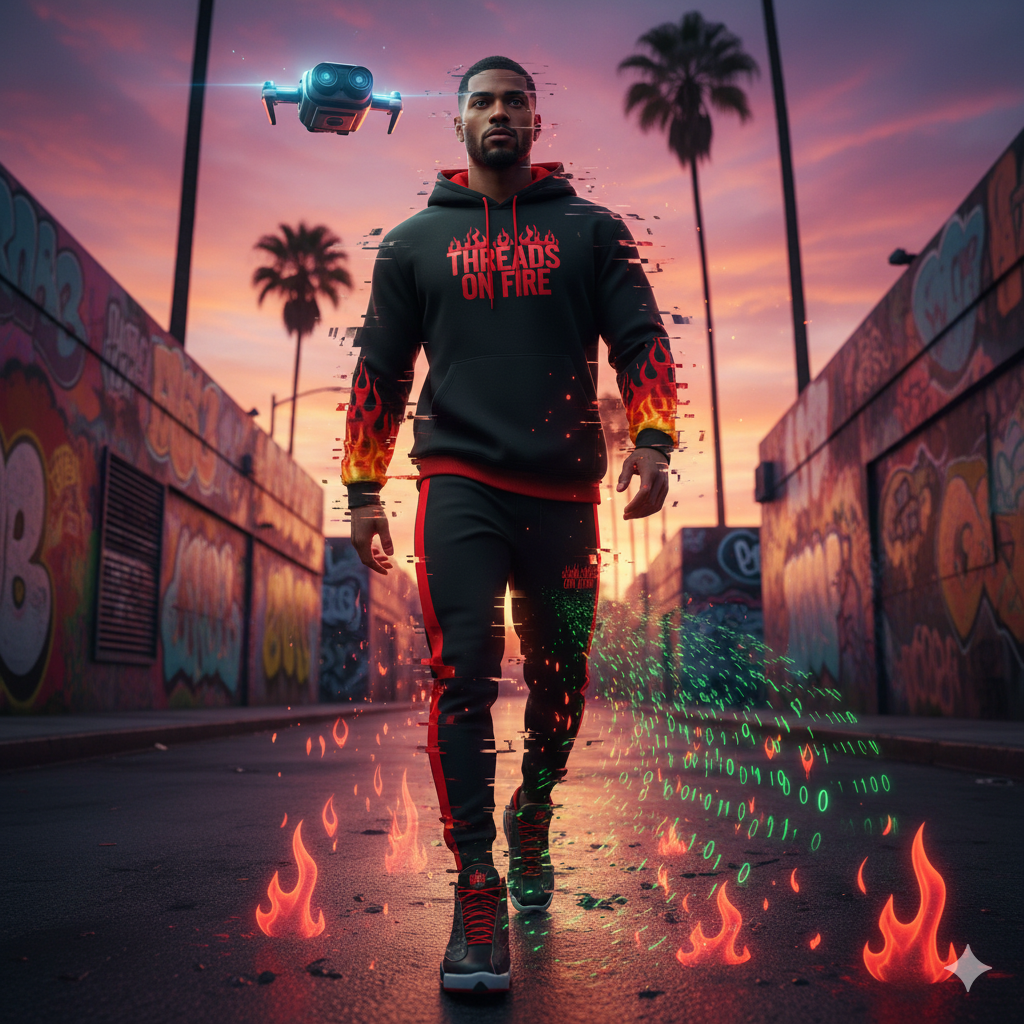
L.A.'s Digital Influencers and AI Models: When Virtual Models Wear Real Hoodies
Table of Contents
- The Rise of LA’s Virtual Style Icons
- Miquela: The First Digital It-Girl
- Blawko22: The AI Bad Boy of Los Angeles
- AI Models & The Future of Streetwear Campaigns
- The Controversy: Authentic or Artificial?
- Threads On Fire x The Digital Streets
- Shop the Fire
The Rise of LA’s Virtual Style Icons

What happens when streetwear meets simulation? In Los Angeles — the city that invented both Hollywood fantasy and sneaker realism — the next wave of influencers aren’t human at all. They’re AI-generated avatars built to represent everything from luxury minimalism to West Coast grit.
Virtual influencers like Lil Miquela and Blawko22 have blurred the line between fashion and fiction. They post selfies, drop outfit reels, and debate culture just like real people — except they’re coded in polygons and powered by marketing data. Yet, their impact is very real: millions of followers, sponsorships with brands like Prada and Calvin Klein, and cultural influence that rivals flesh-and-blood creators.
For streetwear brands, this isn’t science fiction — it’s the new front line of storytelling.
Miquela: The First Digital It-Girl

Created by LA-based start-up Brud, Miquela is part influencer, part cultural experiment. She lives “digitally” in Los Angeles, posts from Venice Beach and Silver Lake, and switches effortlessly between Supreme hoodies, Stussy tees, and Prada skirts. Her aesthetic is the definition of West Coast hybrid — tech meets nostalgia, pixel meets pavement.
Miquela’s success proved one thing: digital personalities could carry authentic cultural influence if they tapped into the right mix of fashion, music, and emotion. Her followers interact as if she’s real — because, on the internet, perception is reality.
Blawko22: The AI Bad Boy of Los Angeles

If Miquela is the angel of the simulation, Blawko22 is the devil in a hoodie. Known for his tattoos, red bandanas, and unapologetic “bad-boy energy,” Blawko represents the masculine edge of digital LA. He’s the street-coded counterpart to luxury’s digital models — rocking streetwear, posting in front of murals, and talking like he’s from the East Side.
He’s also proof that the AI influencer space isn’t just about perfection — it’s about attitude. That’s why Blawko would fit naturally in a Threads On Fire hoodie and joggers set. He embodies the duality TOF celebrates: real rebellion, even if it’s simulated.
AI Models & The Future of Streetwear Campaigns

For brands, AI models are game-changers. They let designers simulate outfits, perfect fabric flow, and preview colorways before a single sample is made. They can appear in any city, any light, wearing any sneaker you want — all before the product even exists.
That’s why companies are using AI avatars to test fits, run virtual photoshoots, and gather data on engagement — every post becomes a lab experiment. In a city like Los Angeles, where creative tech and streetwear collide daily, it’s no surprise that AI models are becoming part of the local aesthetic.
For streetwear brands like Threads On Fire, this technology opens doors to new possibilities: digital twins of our Streetwear Essentials, AI-modeled looks that match real sneaker drops, and creative collaborations with digital artists who speak the same visual language as the next generation.
The Controversy: Authentic or Artificial?

Virtual influencers bring hype — but also heat. Critics accuse digital avatars of cultural appropriation, unrealistic beauty standards, and emotional manipulation. Miquela’s “Latina identity,” for example, sparked conversations about representation and authenticity in fashion marketing.
But even those controversies fuel virality. Every headline, every argument, every repost adds to the mythos — and that’s what today’s attention economy runs on. The tension between authenticity and artifice is what makes AI streetwear so magnetic.
And if you think about it, that tension isn’t new — it’s the same one streetwear has always wrestled with. From fake Jordans to hypebeast clones, the culture’s long been navigating what’s real versus what just looks real.
Threads On Fire x The Digital Streets
At Threads On Fire, we’re not afraid of the future. We see AI and virtual fashion not as threats, but as new canvases for creativity. Imagine a digital Threads On Fire avatar — born in L.A., built with attitude, walking through Crenshaw murals, vlogging from Melrose, rocking the latest hoodie and joggers set.
This digital presence could drop hints about new collections, share stories of sneaker culture, and explore how West Coast identity translates in the metaverse. We’d bridge the real and the virtual — not to escape reality, but to remix it with fire.
Because whether the model’s pixels or flesh, the energy behind the brand stays the same: authentic, confident, and unapologetically street.
Shop the Fire









2 comments
s4zvuf
s4zvuf